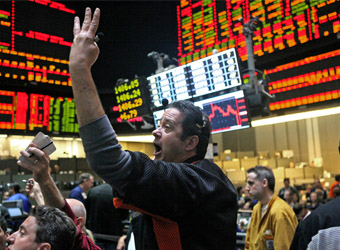U.S. stocks rallied on Friday, with Wall Street clearing weekly losses and posting its best two-day gain in four months, as investors decided the nonfarm payrolls report wasn’t so terrible after all.
“It was bad, but not that bad,” said Marc Doss, regional chief investment officer at Wells Fargo Private Bank. “We’ve made some progress here, and we still think we’ll get back to a better trend,” he added.
The government reported the creation of 113,000 jobs in January versus expectations of 185,000. The jobless rate fell to 6.6 percent versus an expectation of 6.7 percent.
The report showed increased employment in construction, and declines in retail and government work.
The payroll number is “even lower than the lowest estimate. Mitigating some of these negatives is the unemployment rate ticked a bit lower and the labor participation rate ticked up. Both of those are good things,” said Chris Gaffney, senior market strategist at EverBank.
“We’re still in the 130,000 to 150,000 range in looking at the six-month average, so I don’t think this will deter the Fed from their tapering program,” said Paul Nolte, managing director at Dearborn Partners, in downplaying any notion that the jobs report might prompt the central bank to discontinue its program of easing its quantitative easing.
“The economic data is still okay; the earnings data, which is driving the market more than anything else, is also okay. We’re not running into a higher probability of a recession. As a result the markets can stay in relatively broad trading range,” said Nolte, who believes the S&P 500 will travel in a zone of about 5 percent, between 1,750 and 1,850.
S&P 500 companies are on track to “print an earnings per share number 9 to 10 percent higher; revenue is only going to be up about 2 to 3 percent, so the top line is a longer-term worry, but on the bottom line, companies have delivered for another quarter,” said Doss.
|
|
Name |
Price |
|
Change |
%Change |
|
DJIA |
Dow Jones Industrial Average |
15794.08 |
|
165.55 |
1.06% |
|
S&P 500 |
S&P 500 Index |
1797.02 |
|
23.59 |
1.33% |
|
NASDAQ |
Nasdaq Composite Index |
4125.86 |
|
68.74 |
1.69% |
The Dow Jones Industrial Average rose 165.55 points, or 1.1 percent, to 15,794.08, with Boeing leading gains that included 29 of its 30 components.
The S&P 500 gained 23.59 points, or 1.3 percent, to 1,797.02, with health care and industrials leading sector gains that included all 10 of the index’s major industry groups.
Both the Dow and the S&P 500 posted their best week of the year, with the former up 0.6 percent and the latter rising 0.8 percent from last Friday’s finish.
Shares of Expedia rallied after the online travel site reported fourth-quarter results above expectations. Competitor TripAdvisor also gained. Cigna fell sharply after the insurance provider posted a lower fourth-quarter profit and gave a 2014 earnings forecast beneath estimates.
Rising 0.5 percent from last Friday’s close, the Nasdaq rose 68.74 points, or 1.7 percent, to 4,125.86.
For every share falling, more than three rose on the New York Stock Exchange, where 764 million shares traded. Composite volume neared 3.8 billion.
Treasury prices rose, with the yield on the 10-year note falling 2 basis points to 2.682 percent; the dollar declined against currency rivals.
Crude-oil futures for March delivery rose $2.04, or 2.1 percent to $99.88 a barrel.Gold for April delivery rose $5.70, or 0.5 percent, to $1,262.90 an ounce.
The equities market remains in a corrective phase, according to EverBank’s Gaffney, who notes the down days have involved heavier trading volume than up days.
Friday’s nonfarm payrolls report follows terrible data in December, which was revised just a bit, up 1,000 from the previous estimate of 74,000.
Stock futures initially fell on the report, but recovered within minutes.
Lousy data on the labor market aside, U.S. economic momentum has been picking, Dallas Federal Reserve President Richard Fisher told CNBC on Friday. The hawkish Fisher, a voting member of the Federal Open Market Committee, said the Fed was unlikely to sway the Fed from continuing to scale back its monthly asset purchases.
On Thursday, U.S. stocks surged, with the Dow Jones Industrial Average marking its best session this year, as Wall Street embraced a drop in applications for jobless benefits as indicative of an improving U.S. labor market and economy, a day ahead of the monthly jobs report. The Fed’s next policy-setting session is in March.
Source: CNBC
